A-class: Difference between revisions
Pbcjohnston (talk | contribs) |
Pbcjohnston (talk | contribs) |
||
| Line 48: | Line 48: | ||
The two men in shadow in front of the bridge seem to be officers and more likely are day riders. The flag at the top of the periscope looks to be a Squadron flag and has the numeral “1” on it. One of the men may be the Commodore of the 1st Submarine Group, Pacific Torpedo Flotilla, Ensign James Perdue Olding and possibly his aide. One man is wearing a necktie and both are wearing officer's caps. There looks to be one Chief topside. The crew was mostly made up of rated personnel. The Navy was taking only volunteers and the most experienced in their rates at that time. The Chief standing between the two ventilators is either GMC Raymond Ryan or EMC William H. Essig. These two men were known to have been aboard during the time frame of this photo but no identified images of either man has been found up to this time. | The two men in shadow in front of the bridge seem to be officers and more likely are day riders. The flag at the top of the periscope looks to be a Squadron flag and has the numeral “1” on it. One of the men may be the Commodore of the 1st Submarine Group, Pacific Torpedo Flotilla, Ensign James Perdue Olding and possibly his aide. One man is wearing a necktie and both are wearing officer's caps. There looks to be one Chief topside. The crew was mostly made up of rated personnel. The Navy was taking only volunteers and the most experienced in their rates at that time. The Chief standing between the two ventilators is either GMC Raymond Ryan or EMC William H. Essig. These two men were known to have been aboard during the time frame of this photo but no identified images of either man has been found up to this time. | ||
The tall “pole” is the periscope. These early periscopes were fixed and only pointed forward. They did offer some protection allowing the submarine to be deeper and not needing to broach to see out of the deadlights in the conning tower. | The tall “pole” is the periscope. These early periscopes were fixed in place and only pointed forward. They did offer some protection allowing the submarine to be deeper and not needing to broach to see out of the deadlights in the conning tower. | ||
At the base of the periscope is the magnetic compass binnacle. They were placed above and as far away from the steel hulls as possible. The compass was viewed through a series of mirrors. Just behind the conning tower near the “X” bracing for the bridge is the ship's air whistle.</span> | At the base of the periscope is the magnetic compass binnacle. They were placed above and as far away from the steel hulls as possible. The compass was viewed through a series of mirrors. Just behind the conning tower near the “X” bracing for the bridge is the ship's air whistle.</span> | ||
Revision as of 21:18, 11 October 2023

Design, Construction, and Naming Notes
Plunger/A-1 (Submarine No. 2)
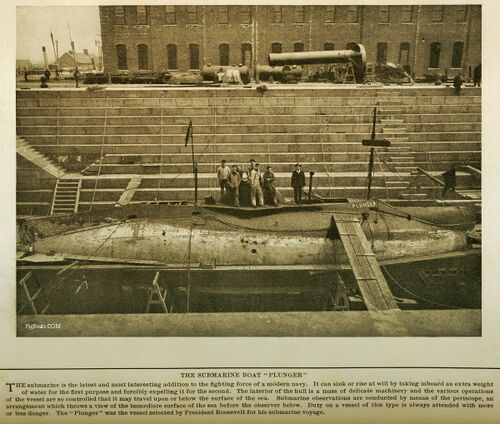
Adder/A-2 (Submarine No. 3, later SS-3)
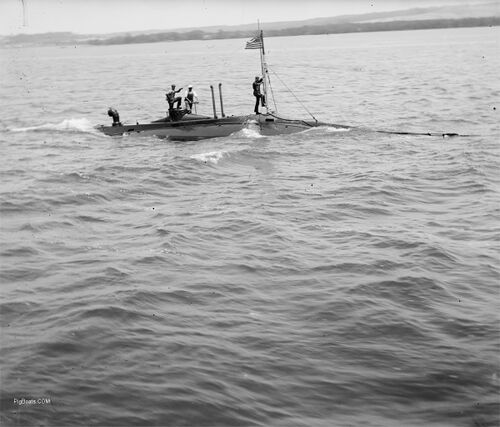
Grampus/A-3 (Submarine No. 4, later SS-4)
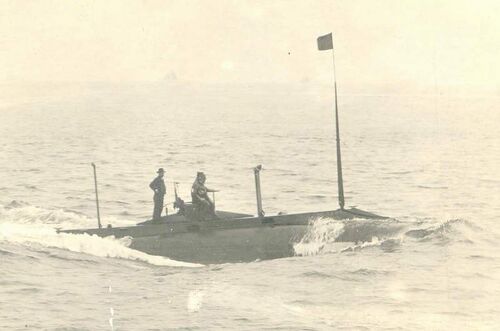
Moccasin/A-4 (Submarine No. 5, later SS-5)

Pike/A-5 (Submarine No. 6, later SS-6)
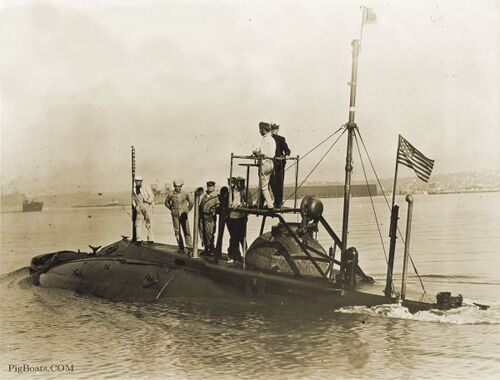
The helmsman, standing next to Donavin, seems to be smoking a pipe. Note that the shaft for the helm extends down into the pressure hull. It mates up to the below deck helm. The topside helm is removable and was usually stored outboard the torpedo tube inside the hull. The man standing at the left and leaning on the jackstaff looks to have pinned the commissioning pennant so it wouldn’t flap in his and the others faces.
The two men in shadow in front of the bridge seem to be officers and more likely are day riders. The flag at the top of the periscope looks to be a Squadron flag and has the numeral “1” on it. One of the men may be the Commodore of the 1st Submarine Group, Pacific Torpedo Flotilla, Ensign James Perdue Olding and possibly his aide. One man is wearing a necktie and both are wearing officer's caps. There looks to be one Chief topside. The crew was mostly made up of rated personnel. The Navy was taking only volunteers and the most experienced in their rates at that time. The Chief standing between the two ventilators is either GMC Raymond Ryan or EMC William H. Essig. These two men were known to have been aboard during the time frame of this photo but no identified images of either man has been found up to this time.
The tall “pole” is the periscope. These early periscopes were fixed in place and only pointed forward. They did offer some protection allowing the submarine to be deeper and not needing to broach to see out of the deadlights in the conning tower.
At the base of the periscope is the magnetic compass binnacle. They were placed above and as far away from the steel hulls as possible. The compass was viewed through a series of mirrors. Just behind the conning tower near the “X” bracing for the bridge is the ship's air whistle.
Porpoise/A-6 (Submarine No. 7, later SS-7)
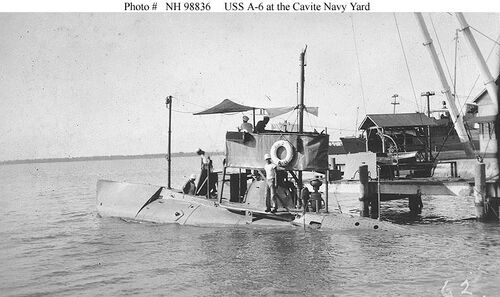
Shark/A-7 (Submarine No. 8, later SS-8)
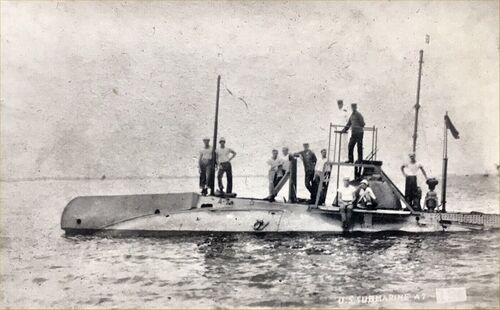
General A-class and group photos
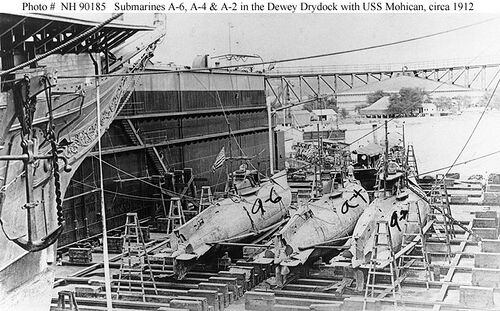
USS Dewey (Drydock No. 1, later YFD-1) was a fixture in Subic Bay for over 37 years. She provided invaluable repair services to dozens of Asiatic Fleet ships and submarines during her career. She was scuttled by U.S. forces to prevent capture in early 1942, but was raised and reconditioned by the Japanese. She was sunk a 2nd time by U.S. forces in 1944 and destroyed.
See more General A-class and Group photos
Page created by:
Ric Hedman & David Johnston
1999 - 2023 - PigBoats.COM©
Mountlake Terrace, WA, Norfolk, VA
webmaster at pigboats dot com